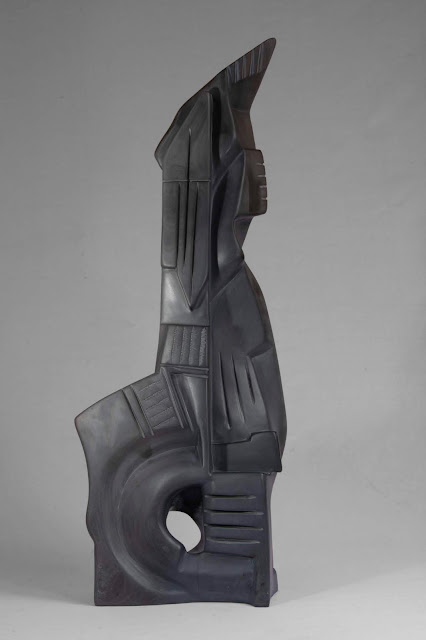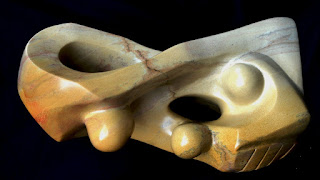By
Margaretta wa Gacheru (posted 20 August 2018)
One of Picasso's Cubist paintings
Yet few people probably know how much inspiration Picasso drew as an artist from Africa, especially from the sculptures and masks of West Africa.
Yet few people probably know how much inspiration Picasso drew as an artist from Africa, especially from the sculptures and masks of West Africa.
Picasso,
Matisse and other painters of that time were all impressed with the artifacts
extracted from indigenous African cultures and put on display in Parisian
museums and private collections. So much so that they went on to create a major
cultural movement which has its roots in the African aesthetic, called Cubism.
Yet up until
quite recently, most Western art critics have tended to forget that Cubism was inspired
by African art. At best, they admit Picasso went through a brief (1906-1909) ‘African
period’.
New Year's Celebration by Robin Mbera
One Kenyan sculptor who hasn’t forgotten that Cubists owe Africa a debt of gratitude for the profound influence that sub-Saharan sculpture has had on their art, is Robin Okeyo Mbera.
One Kenyan sculptor who hasn’t forgotten that Cubists owe Africa a debt of gratitude for the profound influence that sub-Saharan sculpture has had on their art, is Robin Okeyo Mbera.
At the
opening of his ‘Afro-Cubism: Journey #1” exhibition this past weekend at
Nairobi National Museum, Robin explained his reason for spending the last five
years preparing for this exhibition.
It was to
pick up from where the Cubist painters left off and reclaim the influence and
the legacy that Africa has had on art and world culture.
Brothers by Robin Mbera
Brothers by Robin Mbera
Five years
ago, Robin’s dream wasn’t merely to emulate Western art or to pay homage to the
Cubists. It was to retrieve the artistic incentive inspired by early
sub-Saharan sculptors. And for him the best way to do that was as a sculptor
himself, to work in stone indigenous to Kenya.
Afro-Cubism
is a name Robin personally coined for the artworks that he hoped to create. It
is also the title of the five-year plan he proposed to Kenya’s leading
collector of Kisii stone art, Mutuma Marangu.
Fortunately,
Mr Mutuma responded positively to Robin’s idea. And ever since then, the
sculptor has been creating original works out of stones extracted from his
homeland in Tabaka, Kisii County.
Math Africa by Robin Mbera
His prototype, the one originally shown to Mutuma with his proposal, was carved out of Kisii stone. But all the other 25 sculptures (which are tastefully displayed in chronological order in the Museum’s Creativity Gallery) have been carved out of Silicate, a hard grey stone that Robin says is much rarer in the region than the traditional Kisii soapstone.
His prototype, the one originally shown to Mutuma with his proposal, was carved out of Kisii stone. But all the other 25 sculptures (which are tastefully displayed in chronological order in the Museum’s Creativity Gallery) have been carved out of Silicate, a hard grey stone that Robin says is much rarer in the region than the traditional Kisii soapstone.
All 26
sculptures in Robin’s ‘Journey #1’ have the good fortune of already being part
of the larger Mutuma Marangu Sculpture Collection. That collection (not even a
fraction of it) has never been put on public display before. So the Museum has
the good fortune of showing off what is undeniably one of the most important
art collections owned by any Kenyan.
Other
Kenyans may be collecting art and building up their collections. One hopes this
is the case. But none other than Mutuma has focused exclusively on Kisii
sculpture. This far-sighted Kenyan businessman owns countless masterpieces by such
major Kisii sculptors as Elkana Ong’esa, Gerald Motondi, Duke Kombo, Peter
Kenyanya and Robin Mbera.
By Gerald Motondi, another Kisii artist
By Gerald Motondi, another Kisii artist
And because
‘Afro-Cubism’ is the first exposure of his collection to the world, Mutuma told
Business Daily that he’s worked with a team to display Robin’s sculptures in a systematic,
professional style. With his team, he says he has produced a documentary on the
collection, filmed by Morris Keyonzo and narrated by his daughter, Kinya Mutuma.
He’s also created informative panels describing Robin’s art, including the
ten-step process he has gone through to create every single one of his
sculptures.
What’s more,
every sculpture is thoughtfully captioned, photographed from various angles,
and included in a 64-page catalogue that lays out all that has gone into
curating and mounting this outstanding show. The content of the book is also
now online at www.afro-cubism.ke.
Both the book and website were designed by Armstrong Mutuma.
The one
sculpture that is not in the booklet (but is on display) is Robin’s 27th
sculpture, which effectively launches hi and Mutuma’s ‘Journey #2’ of
Afro-Cubism. Conceived and crafted out of green basalt, this 27th
work embodies the faith that Mr Mutuma has in Robin’s artistic capacity to
continue creating works like his ‘Black Kingdom’, ‘Nairopean’, ‘Brother’,
‘Breadwinner’ and ‘Territory Defender.’
One might
also see it as a sign that Mutuma knows Kenyan art, especially Kisii sculpture,
is bound to one day be recognized as world-class art as well as a wise
financial investment.







No comments:
Post a Comment